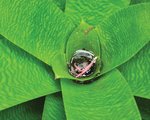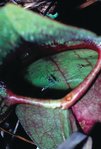Known as container mosquitoes because of the small aquatic habitats they dwell in until adulthood, they include several invasive species that may transmit viruses...
Join our family of readers for as little as $5 per month and support local, unbiased journalism.
Already have an account? Log in to continue. Otherwise, follow the link below to join.
Please log in to continue |


VERO BEACH — A water fountain to decorate a garden, a cluster of colorful plant pots and saucers on a patio, and a bird bath on a terrace can each delight the eye. However, if these simple yard accessories hold standing water, they may also be habitats for the immature stages of mosquitoes.
Scientists at the University of Florida Institute of Food and Agricultural Sciences (UF/IFAS) have released “Florida Container Mosquitoes1”, a guide designed to bring awareness to container mosquitoes and the types of habitats and water-holding vessels where mosquito aquatic stages can occur.
To the unsuspecting, a discarded tire left unattended behind a garage, a large fallen palm leaf that collects rainwater on a lawn, an unchecked tree hole, and even an ornamental bromeliad plant can hold water. Such vessels may be attractive for mosquitoes specialized to occupy such habitats and serve as the perfect home for their developing stages.
Known as container mosquitoes because of the small aquatic habitats they dwell in until adulthood, they include several invasive species that may transmit viruses such as dengue, yellow fever, chikungunya and Zika. Published in the UF/IFAS Electronic Data Information Source (EDIS), which hosts peer-reviewed publications by faculty and Extension professionals, the document lists and illustrates 15 species of mosquitoes, 11 native and four exotic, that scientists classify as preferring to occupy containers.
“We hope that readers of this guide will appreciate the types and breadth of containers that Florida mosquitoes may occupy and, where appropriate, reduce the potential for mosquito pests and disease vectors by emptying or draining man-made containers in their yards,” said Philip Lounibos, a distinguished professor emeritus of ecology and behavior at UF/IFAS Florida Medical Entomology Laboratory in Vero Beach.
Adult female container mosquitoes lay their eggs in small vessels that hold water. After the larvae hatch, they spend their aquatic stages in these containers until they emerge as adults. According to the document, container mosquitoes represent approximately 20 percent of the 90 mosquito species currently known to occur in Florida.
“It is only relatively recently, following the increased prevalence of exotic viruses such as dengue, chikungunya, and Zika, vectored by the invasive container species Aedes aegypti and Aedes albopictus, that mosquito control efforts in Florida have begun to focus intensively on mitigating the impact of these two species, especially in densely populated areas of the state,” said Lounibos.“On the other hand, many of Florida’s native container mosquitoes such as the pitcher plant specialist Wyeomyia smithii are not interested in biting humans and carry no known pathogens.”
A closer look at your property may also reveal natural container habitats used by mosquitoes which include plant cavities such as bromeliad tanks and axils, tree holes and flower bracts of tropical plants, or decorative rocks with depressions that hold rain or irrigation water.
The document also considers which species are identified as “true” container mosquitoes in contrast to species that may occasionally seek these water vessels to lay eggs in, said Lounibos.
“True container mosquitoes are those that use this habitat faithfully and should be differentiated from other species of Florida mosquitoes, such as Culex quinquefasciatus, the Southern House Mosquito, which may occasionally be found in large containers, such as discarded auto tires, but do not favor such habitats,” said Lounibous.
Lounibos and co-author Eva Buckner, an assistant professor and medical entomology UF/IFAS Extension specialist at the research center in Vero Beach, also detail how to control container mosquito pests at a time when the rainy season provides the optimal environment for filling their small aquatic habitats.
The document carefully distinguishes between mosquito control methods that can be used by homeowners and property owners versus large-scale control methods reserved for governmental or nongovernmental organizations potentially requiring scientific oversight and community participation.
In the guide, Lounibos and Buckner explain that among control methods that can be easily applied by homeowners, the most efficacious is the reduction of container mosquito numbers by eliminating their aquatic habitats, such as by draining plant trivets or bird baths, favorable for mosquito growth.